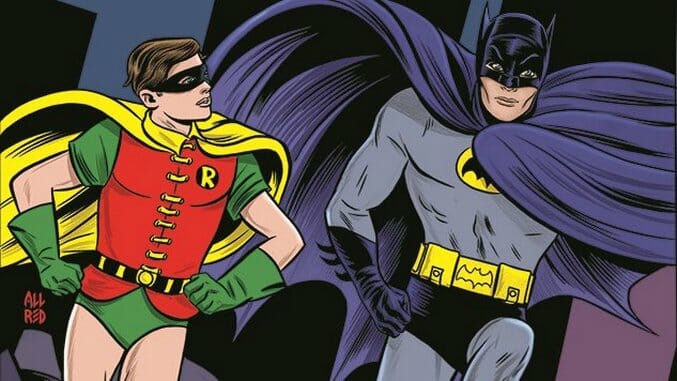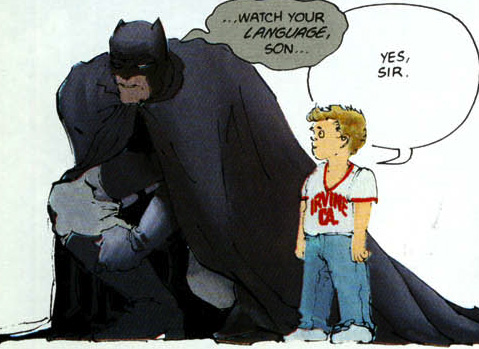The Enduring Impact of Adam West’s Batman on Comics
Main Art by Mike Allred
As the world mourns the death of the wonderful Adam West, one fact is indisputable: his Batman was one of the most iconic and influential performances in the history of TV. Multimedia traces of that performance have been easier to find than ever lately. The LEGO Batman Movie channels the Day-Glo glee of the TV series into new directions. If you ever go to a barcade, you might find a ‘60s-themed Batman pinball game. Deadpan comedians including Stephen Colbert owe a debt to West, who has been featured on Family Guy since 2002.
But Adam West’s Batman wasn’t just spawned by comic books; he personally had a massive ongoing impact on the character’s evolution. Whether Batman comics were embracing, rejecting, homaging or reviving the influence of the TV show, the shadow of West’s caped crusader was never far.
A good point to start any discussion of Batman’s history is with comic writer Grant Morrison, whose run on various Bat-titles from 2006-2013 supported a unique premise: every Batman story ever counted in continuity—even the TV series. Morrison once gave Rolling Stone an accurate summary of the show’s evolving reception: “The Sixties Batman works because when you’re a kid you take it really seriously and when you’re an adult, you think it’s pretty funny. But when you’re an adolescent and you’re getting into Batman as an idea of something cool and mysterious and reflection of your own darker moods – that’s when you really hate that Adam West stuff. It’s anathema to the adolescent concept of Batman as a tortured, angst-ridden loner. But obviously the older you get, the funnier it gets.” This love-hate-love story mirrors major trends in Batman comics since the 1950s.
Batman may have been created in 1939, but the story of the Batman TV show began in the 1950s, when the Comics Code neutered gritty elements and things got weird. Batman, originally a grim avenger with a gun, became a planet-hopping goofball. If you think the TV show is silly, read his 1950s stories about the Rainbow Batman, hyper-imp Bat-Mite, the Batman of Zur-En-Arrh and faithful Ace the Bat-Hound, a German shepherd in a domino mask. The TV show offered stark realism in comparison to these flights of tongue-in-cheek fantasy.
Post-TV show, two classic periods of Batman have been described as reactions against the campy phenomenon: the tales created by writer Denny O’Neil and artist Neal Adams in the 1970s as well as Frank Miller’s influence throughout the ‘80s. O’Neil and Adams were the first to bring Batman back to his roots as a down-to-earth detective, with the scripts and art providing a far more serious contrast. Classics like “The Joker’s Five-Way Revenge” set an anti-camp tone, which was also highlighted by the creation of Batman’s Moriarity, Ra’s al Ghul, and his gorgeous daughter, Talia. This was adult stuff. A guy who carried Shark Repellent Bat-Spray wouldn’t last a minute in swordplay with Ra’s or under Talia’s seduction.
Miller upped the darkness and quality with his 1980s classics Batman: Year One and The Dark Knight Returns, which have also been incessantly described as antidotes to the Adam West Batman. (Funny how the show kept provoking rebuttals.) Even as West and company faded 20 years into the past, their impression on pop culture remained deep and bright. But Miller didn’t simply drive the Batmobile as far away from the ‘60s as possible. He also included a few 1960s homages, which are a Bat-tradition in themselves.
In The Dark Knight Returns, Commission Gordon calls on a red Bat-phone, just like in the TV show, and when Batman is bleeding in an amusement park during a battle with the Joker, his admonishment to a foul-mouthed youngster is pure West: “Watch your language, son.” This cornball touch can also be seen in Alan Moore’s 1985 Superman annual “For the Man Who Has Everything.” After Jason Todd meets Wonder Woman for the first time and is understandably flustered, Batman “Wests” it up with his response, “Think clean thoughts, chum.”



